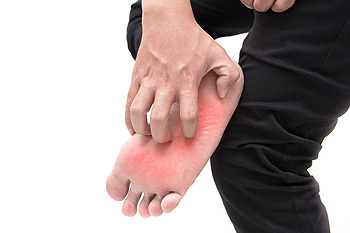How Did I Contract Athlete’s Foot?
Monday, 11 May 2020 00:00 Skin that is red and peeling between the toes can be indicative of a condition that is known as athlete’s foot. It is a fungal infection, and is caused by fungus that lives and thrives in warm and moist environments. These can consist of public swimming pools, locker rooms, and communal showers. Additional symptoms may include severe itchiness, blisters, and the skin may become thick and cracked. Helpful prevention methods can involve wearing appropriate shoes while in these areas, followed by washing and drying the feet thoroughly. Athlete’s feet can cause pain and discomfort. If you think you are afflicted with this ailment, it is strongly suggested that you consult with a podiatrist who can prescribe the necessary medication for an effective treatment.
Skin that is red and peeling between the toes can be indicative of a condition that is known as athlete’s foot. It is a fungal infection, and is caused by fungus that lives and thrives in warm and moist environments. These can consist of public swimming pools, locker rooms, and communal showers. Additional symptoms may include severe itchiness, blisters, and the skin may become thick and cracked. Helpful prevention methods can involve wearing appropriate shoes while in these areas, followed by washing and drying the feet thoroughly. Athlete’s feet can cause pain and discomfort. If you think you are afflicted with this ailment, it is strongly suggested that you consult with a podiatrist who can prescribe the necessary medication for an effective treatment.
Athlete’s Foot
Athlete’s foot is often an uncomfortable condition to experience. Thankfully, podiatrists specialize in treating athlete’s foot and offer the best treatment options. If you have any questions about athlete’s foot, consult with Dr. Robert Graser from Graser Podiatry and Bunion Surgery Institute. Our doctor will assess your condition and provide you with quality treatment.
What Is Athlete’s Foot?
Tinea pedis, more commonly known as athlete’s foot, is a non-serious and common fungal infection of the foot. Athlete’s foot is contagious and can be contracted by touching someone who has it or infected surfaces. The most common places contaminated by it are public showers, locker rooms, and swimming pools. Once contracted, it grows on feet that are left inside moist, dark, and warm shoes and socks.
Prevention
The most effective ways to prevent athlete’s foot include:
- Thoroughly washing and drying feet
- Avoid going barefoot in locker rooms and public showers
- Using shower shoes in public showers
- Wearing socks that allow the feet to breathe
- Changing socks and shoes frequently if you sweat a lot
Symptoms
Athlete’s foot initially occurs as a rash between the toes. However, if left undiagnosed, it can spread to the sides and bottom of the feet, toenails, and if touched by hand, the hands themselves. Symptoms include:
- Redness
- Burning
- Itching
- Scaly and peeling skin
Diagnosis and Treatment
Diagnosis is quick and easy. Skin samples will be taken and either viewed under a microscope or sent to a lab for testing. Sometimes, a podiatrist can diagnose it based on simply looking at it. Once confirmed, treatment options include oral and topical antifungal medications.
If you have any questions, please feel free to contact our office located in Boerne, . We offer the newest diagnostic and treatment technologies for all your foot care needs.
Featured Articles
- July 2024
- June 2024
- May 2024
- April 2024
- March 2024
- February 2024
- January 2024
- December 2023
- November 2023
- October 2023
- September 2023
- August 2023
- July 2023
- June 2023
- May 2023
- April 2023
- March 2023
- February 2023
- January 2023
- December 2022
- November 2022
- October 2022
- September 2022
- August 2022
- July 2022
- June 2022
- May 2022
- April 2022
- March 2022
- February 2022
- January 2022
- December 2021
- November 2021
- October 2021
- September 2021
- August 2021
- July 2021
- June 2021
- May 2021
- April 2021
- March 2021
- February 2021
- January 2021
- December 2020
- November 2020
- October 2020
- September 2020
- August 2020
- July 2020
- June 2020
- May 2020
- April 2020
- March 2020
- February 2020
- January 2020
- December 2019
- November 2019
- October 2019
- September 2019
- August 2019
- July 2019
- June 2019
- May 2019
- April 2019
- March 2019
- February 2019
- January 2019
- December 2018
- November 2018
- October 2018
- September 2018
- August 2018
- July 2018
- June 2018
- May 2018








